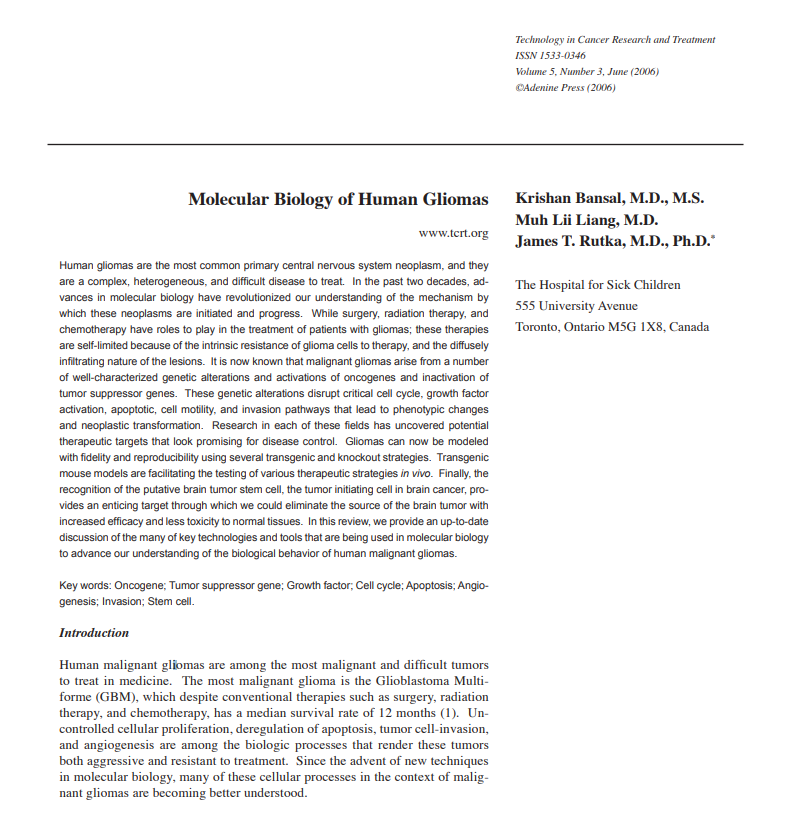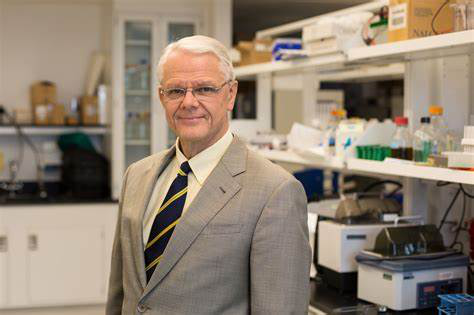人类胶质瘤的分子生物学(Molecular Biology of Human Gliomas) 英语摘要: Human gliomas are the most common primary central nervous system neoplasm, and they are a complex, heterogeneous, and difficult disease to treat. In t...
人类胶质瘤的分子生物学(Molecular Biology of Human Gliomas)
英语摘要:
Human gliomas are the most common primary central nervous system neoplasm, and they are a complex, heterogeneous, and difficult disease to treat. In the past two decades, advances in molecular biology have revolutionized our understanding of the mechanism by which these neoplasms are initiated and progress. While surgery, radiation therapy, and chemotherapy have roles to play in the treatment of patients with gliomas; these therapies are self-limited because of the intrinsic resistance of glioma cells to therapy, and the diffusely infiltrating nature of the lesions. It is now known that malignant gliomas arise from a number of well-characterized genetic alterations and activations of oncogenes and inactivation of tumor suppressor genes. These genetic alterations disrupt critical cell cycle, growth factor activation, apoptotic, cell motility, and invasion pathways that lead to phenotypic changes and neoplastic transformation. Research in each of these fields has uncovered potential therapeutic targets that look promising for disease control. Gliomas can now be modeled with fidelity and reproducibility using several transgenic and knockout strategies. Transgenic mouse models are facilitating the testing of various therapeutic strategies in vivo. Finally, the recognition of the putative brain tumor stem cell, the tumor initiating cell in brain cancer, provides an enticing target through which we could eliminate the source of the brain tumor with increased efficacy and less toxicity to normal tissues. In this review, we provide an up-to-date discussion of the many of key technologies and tools that are being used in molecular biology to advance our understanding of the biological behavior of human malignant gliomas.

中文摘要:
人脑胶质瘤是较常见的原发性中枢神经系统肿瘤,是一种复杂、异质性、难治的疾病。在过去的二十年里,分子生物学的进步完全改变了我们对这些肿瘤产生和发展机制的理解。而手术、放疗和化疗在胶质瘤患者的治疗中发挥作用;由于胶质瘤细胞对治疗具有固有的耐药性,且病变具有弥漫性浸润性,这些治疗方法具有局限性。目前已知恶性胶质瘤是由一系列特征明确的致癌基因的改变和激活以及抑癌基因的失活引起的。这些基因改变会损害关键细胞周期、生长因子活化、凋亡、细胞活力以及导致表型改变和肿瘤转化的侵袭通路。这些领域的研究都发现了潜在的治疗靶点,有望用于疾病控制。现在可以使用几种转基因和敲除策略对胶质瘤进行保真和重现性建模。转基因小鼠模型有助于在体内测试各种治疗策略。较后,对假定的
脑肿瘤干细胞的识别,即脑癌中的肿瘤启动细胞,提供了一个诱人的靶点,通过这个靶点,我们可以消除脑肿瘤的来源,提高疗效,降低对正常组织的毒性。在这篇综述中,我们提供了分子生物学中许多关键技术和工具的较新讨论,以增进我们对人类恶性胶质瘤生物学行为的理解。
人类恶性胶质瘤是医学上恶性程度高、难治疗的肿瘤之一。较恶性的胶质瘤是多形性胶质瘤(Glioblastoma Multiforme, GBM),尽管有手术、放疗、化疗等传统治疗方法,但其平均生存率为12个月。既具有侵略性又具有抗药性。随着分子生物学新技术的出现,恶性胶质瘤中的许多细胞过程正在得到更好的理解。
INC国际神经外科医生集团旗下组织国际神经外科顾问团(WANG)成员、国际神经外科学院院长(2011-2014)James T. Rutka教授参与编写。Rutka教授于1990年在神经外科的外科部门任职,并从那时起一直在儿科神经外科的儿童医院的外科医生工作。Rutka教授的主要研究和临床兴趣涉及人类脑肿瘤的科学和手术。他的实验室兴趣在于人类脑肿瘤的分子生物学 - 特别是在确定脑肿瘤生长和侵入的机制方面。
其实验室在研究脑肿瘤生长和侵袭的机制方面颇有成就,并在Sunnybrook健康科学中心和多伦多大学生物材料和生物医学工程研究所的合作下,正在设计一种基于纳米颗粒的输送系统,作为治疗胶质瘤的一种新方法。
INC国际神经外科医生集团一直致力于中外神经外科技术的交流、合作、促进和提高,同时针对高要求人群及脑胶质瘤、
脑膜瘤、
听神经瘤、
垂体瘤、
脑海绵状血管瘤等脑肿瘤和神经外科系统疾病,提供国际前沿的咨询策略和手术方案。
- 相关真实案例
- 点击联系我们
- 文章标题:人类胶质瘤的分子生物学(Molecular Biology of Human Gliomas)
- 更新时间:2019-09-19 17:41:57
-
海绵窦脑膜瘤(CSM)伴眼眶受累对现代神经外科医生提出了一个独特的挑战。海绵窦脑膜...
2020-11-03 10:35:40
-
白介素-13受体IL-13Ralpha2在治疗复发性 恶性胶质瘤 中的表达降低(Decreasing expression of th...
2019-11-18 16:40:53
-
儿童髓母细胞瘤的阵列CGH分析(Array CGH Analysis of Pediatric Medulloblastomas) 英文摘要: Bra...
2019-10-14 17:27:13
-
儿童髓母细胞瘤 或幕上原始神经外胚层肿瘤的饮食干预评价 (Evaluation of Dietetic Interve...
2019-10-21 20:16:10
-
前交通动脉动脉瘤是较具挑战性的动脉瘤之一。随着血管内技术的发展,剩下的挑战是减...
2019-11-13 15:22:44
-
较大嗅沟 脑膜瘤 的消退及停药后视力的完全恢复 (Regression of Giant Olfactory Groove Meningi...
2019-10-17 18:09:49
-
脑膜瘤 为颅内常见良性肿瘤,生长缓慢,多表现为慢性头痛,一般无不同症状,多在中...
2019-10-09 17:53:32
-
由于Sylvian裂隙内复杂的解剖结构和附近的血管因素,岛状胶质瘤代表了一种独特的手术...
2020-11-09 13:18:54
-
髓母细胞瘤 的遗传学:新疗法的线索 (Genetics of medulloblastoma:clues for novel therapies) 英文摘...
2019-11-14 16:42:06
-
成人脑干HGG预后较差,该文分析了在美国近40年来该类患者手术治疗生存情况 ,并于19年...
2020-01-09 16:44:38
-
Cavernous Angiomas of the Brain Stem in Children 儿童脑干海绵状血管瘤 英文摘要: Abstract Out of 2...
2019-09-16 16:24:37
-
儿童低级别脑胶质瘤运用术中磁共振成像如何尽可能地全切除?INC意大利Concezio Di Rocco教...
2020-09-11 13:53:50
-
IGFBP2表达评估idh突变的 胶质瘤 患者生存 (IGFBP2 expression predicts IDH-mutant glioma patient sur...
2019-11-05 17:18:23
-
Abstract The importance of genomic information in intrinsic brain tumors is highlighted in the World Health Organ...
2021-01-07 11:00:58
-
神经外科中具挑战性的技术创新之一是将显微神经外科与成像相结合的跨学科“结合”...
2020-12-22 15:02:45
-
脑胶质瘤手术的临床体会——为了进行根治性切除,已经使用了许多方法来确定手术边缘...
2020-12-04 10:44:34
-
颅咽管瘤的分子发病机制:从手术入路到生物学入路的转变 (Molecular pathogenesis of craniop...
2019-11-07 17:29:51
-
目前,对于难治性 垂体腺瘤 和垂体腺癌发生率、诊断标准、治疗方法以及随访等,国内外...
2019-10-18 18:52:54
-
Abstract Objective:Pituitary adenomas are uncommon in the pediatric population. Although medical treatment can be...
2020-08-25 15:06:02
-
儿童恶性脑瘤并非“无可救药”,目前儿童恶性脑瘤治疗现状如何?未来发展方向是什么...
2020-09-03 11:46:41




